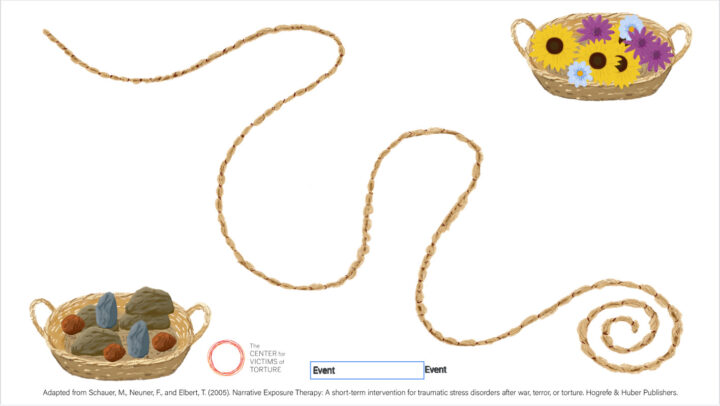These resources are from an in-person Narrative Exposure Therapy training in 2022, through the National Capacity Building Project.
Training Handouts and Suggested Video
- Recording of NET Webinar by Frank Neuner 2016
- CVT NET Training PowerPoint
- Exposure_Hot and Cold Memory Questions
- Fear Network – Web Handout
- NET CONSENT EXAMPLE 2014
- NET Lifeline Example
- NET Psychoeducation
Resources provided by Chris Mehus
- Akiki, T. J., & Abdallah, C. G. (2018). Are There Effective Psychopharmacologic Treatments for PTSD? The Journal of Clinical Psychiatry, 80(3). https://doi.org/10.4088/jcp.18ac12473
- APA. (2016). Narrative Exposure Therapy – Frank Neuner. Retrieved from https://www.youtube.com/watch?v=GhyDplT_uIM
- Crombach, A., & Siehl, S. (2018). Impact and cultural acceptance of the Narrative Exposure Therapy in the aftermath of a natural disaster in Burundi. BMC Psychiatry, 18(1). https://doi.org/10.1186/s12888-018-1799-3
- Foa, E. B., McLean, C. P., Zang, Y., Zhong, J., Powers, M. B., Kauffman, B. Y., … Knowles, K. (2016). Psychometric properties of the Posttraumatic Diagnostic Scale for DSM–5 (PDS–5). Psychological Assessment, 28(10), 1166–1171. https://doi.org/10.1037/pas0000258
- Gwozdziewycs, N. (2013). Meta-Analysis of the Use of Narrative Exposure Therapy for the Effects of Trauma Among Refugee Populations. The Permanente Journal, 17(1), 72–78. https://doi.org/10.7812/tpp/12-058
- Lambert, J. E., & Alhassoon, O. M. (2015). Trauma-focused therapy for refugees: Meta-analytic findings. Journal of Counseling Psychology, 62(1), 28–37. https://doi.org/10.1037/cou0000048
- Lely, J. C. G., Smid, G. E., Jongedijk, R. A., W. Knipscheer, J., & Kleber, R. J. (2019). The effectiveness of narrative exposure therapy: a review, meta-analysis and meta-regression analysis. European Journal of Psychotraumatology, 10(1), 1550344. https://doi.org/10.1080/20008198.2018.1550344
- McPherson, J. (2011). Does Narrative Exposure Therapy Reduce PTSD in Survivors of Mass Violence? Research on Social Work Practice, 22(1), 29–42. https://doi.org/10.1177/1049731511414147
- Mundt, A. P., & Wunsche, P. (2014). Evaluating interventions for posttraumatic stress disorder in low and middle income countries: Narrative exposure therapy. Retrieved September 20, 2022, from psycnet.apa.org website: https://psycnet.apa.org/record/2014-29718-009
- Neuner, F., Schauer, M., & Elbert, T. (2014). On the efficacy of Narrative Exposure Therapy: a reply to Mundt et al. INTERVENTION, 12(2), 267–297. Retrieved from On the efficacy of Narrative Exposure Therapy: a reply to Mundt et al.
- Robjant, K., & Fazel, M. (2010). The emerging evidence for Narrative Exposure Therapy: A review. Clinical Psychology Review, 30(8), 1030–1039. https://doi.org/10.1016/j.cpr.2010.07.004
- Siehl, S., Robjant, K., & Crombach, A. (2020). Systematic review and meta-analyses of the long-term efficacy of narrative exposure therapy for adults, children and perpetrators. Psychotherapy Research, 31(6), 1–16. https://doi.org/10.1080/10503307.2020.1847345
- Use of Benzodiazepines for PTSD in Veterans Affairs – PTSD: National Center for PTSD. (n.d.). Retrieved September 20, 2022, from www.ptsd.va.gov website: Use of Benzodiazepines for PTSD in Veterans Affairs
NCB Resources
Narrative Exposure Therapy for Torture Survivors in Exile: Overview and Adaptations webinar presented by Andrea Northwood, PhD in 2019.

There was also a discussion of how to do this therapy during telehealth visit. NCB created a lifeline that was shown to attendees during the 2021 NCB Virtual NET training. It was created using Jamboard (Google’s whiteboard) as it allowed there to be a background image that was not movable by the user which kept using the lifeline simpler. The background image included the baskets, rope, and the citation. The only items that are moveable are the flowers, rocks, and text boxes marked Events. Each flower and rock have an additional 5 other flowers/rocks behind them. There are multiple Event text boxes as well. The images of the rocks, flowers, baskets, and rope were all drawn by Grace Ogihara at CVT to eliminate any issues with the previous clipart images possibly needing to be purchased or cited. The lifeline whiteboard once complete by the client and the clinician can be downloaded as an image and can be shared with the client if wished. Please contact Sara Bracewell at sbracewell@cvt.org if you are interested in obtaining a copy of this your program.
Looking for more resources?
We may have additional materials on this topic. Feel free to email us at healtorture@cvt.org, and we’ll be happy to check for you. Please make sure to share the name of the course in the email.